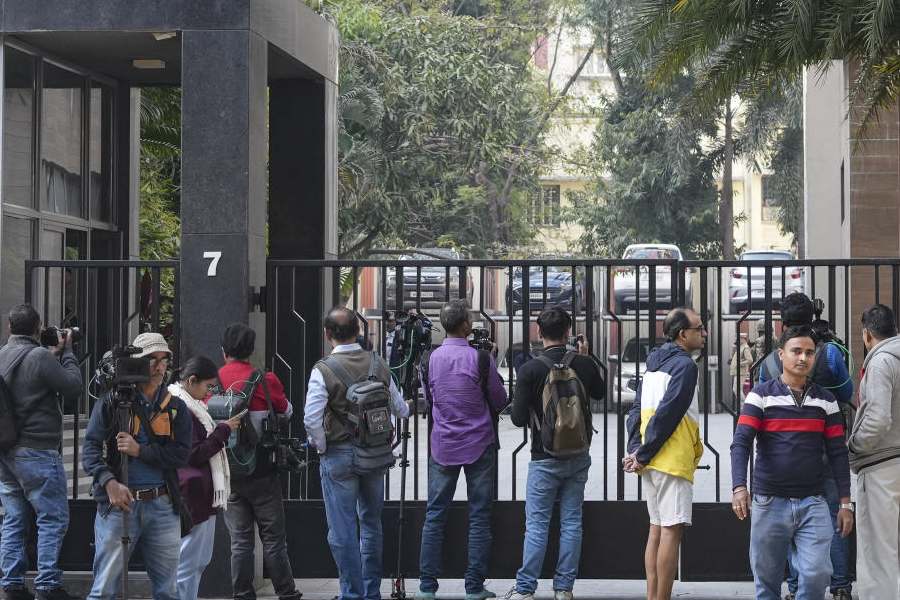 |
 |
| Sumant Kumar (top) with his paddy crop in Nalanda in a picture taken in 2011. (Above) Portion of the form submitted by the farmer for the agriculture award that he received from President Pranab Mukherjee on January 15 this year |
New Delhi/Patna, Feb. 22: Neither a rant from China nor a report from Cuttack is likely to wrest the title of the world’s top rice farmer that Sumant Kumar from Bihar’s Nalanda district earned last year.
Scientists have raised doubts over the claim that Kumar’s patch of land had in 2011 delivered 22.4 tonnes per hectare of paddy, a world record, beating a Chinese farmer who had logged 19.4 tonnes per hectare the previous year.
For his feat, Kumar has received a national agriculture award, been felicitated by President Pranab Mukherjee and Bihar chief minister Nitish Kumar and has spent much of the past year sharing his experience with farmers nationwide.
But a senior Chinese rice scientist who has helped boost China’s rice yields and is known there as the “father of hybrid rice” has questioned Kumar’s farm yield, calling it a false claim.
“It is 120 per cent fake,” Yuan Longping said in an interview to the China News Service. “He [the Indian farmer] said they had lots of rain and little sunshine that year, but high yields would be impossible without adequate sunshine.”
The challenge from China comes amid concerns that yield estimates may not always be correct — whether from farms in China or in India.
A senior Indian crop scientist said China’s yield is typically about 11 to 12 tonnes per hectare. “They claim 18 tonnes in some places, I have my reservations,” a scientist said.
But the claim from Nalanda is also under question from the Central Rice Research Institute (CRRI), Cuttack, a government laboratory that had sent a team of scientists to Kumar’s farm during 2012 to determine its likely yield.
The CRRI plans to submit a technical report on the team’s findings. Senior CRRI scientists say the conditions in the paddy farm during 2012 suggest that the yield will be about 11 tonnes per hectare.
“A 10 tonne or 11 tonne per hectare yield is by itself a good one, but it’s nowhere near the 22.4 tonnes claimed,” Trilochan Mohapatra, CRRI director, told The Telegraph.
Kumar, who is in his early-30s was himself oblivious about his high yield in 2011 until a non-government organisation informed him about a paddy production record held by a Chinese farmer for 2010.
A district agricultural officer, who had certified Kumar’s high yield in 2011, said the figure had been calculated through the standard method adopted by the state.
“It is done in a very transparent manner and the authentication of the figure is done in the presence of the block agricultural officer, circle inspector, statistical supervisor, block development officer, the farmer and a representative of the local panchayat,” Nalanda district agricultural officer Sudama Mahto told The Telegraph over phone.
He said samples for productivity calculations are typically collected from about three per cent of the total sown area in a given district.
But Kumar has an explanation for the dramatic drop in productivity between 2011 and 2012 — a family feud and nationwide travels.
During 2011, he adopted a technique called systematic rice intensification which led to the exceptional high yield, said Rajeev Ranjan, an agriculture university graduate appointed by the Bihar government to disseminate information about latest agricultural practices among farmers.
During 2012, Ranjan said, Kumar was embroiled in a “family feud” and was invited to share his experiences with farmers across the country. “Both these preoccupations kept him away from the farm and he asked some local farmers to handle his farm and they haven’t done it as well as he did,” Ranjan said by way of explanation.
Senior CRRI scientists concede that if the package of paddy management practices changes dramatically, so would the yield. India’s average yield is about 6 tonnes per hectare.
“The 11 tonnes per hectare is a very high yield — if the farm was mismanaged, it would have fallen to four per hectare,” said Mukund Varier, officer-in-charge of the Central Rainfed Upland Rice Research Station, Hazaribagh.
The Chinese farmer Yuan, who has scrutinised published photographs of Kumar’s paddy field, said the harvested plants appear short and couldn’t possibly produce high yields.
“Good soil is the basis of high-yield rice,” Yuan said, adding that the soil where Kumar farmed was apparently inferior in quality.
Yuan also questioned the way India verified Kumar’s claim. “If Kumar is able to repeat his success next year, I will be glad to examine the results in the field personally,” Yuan said.











